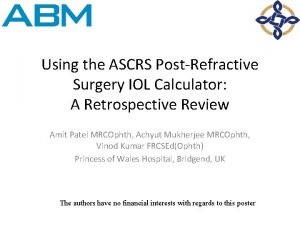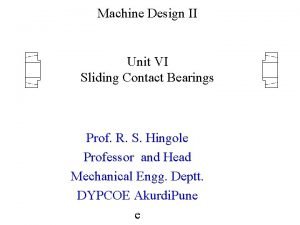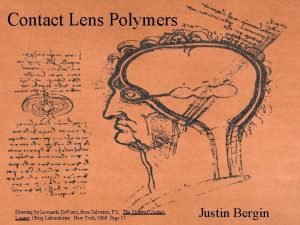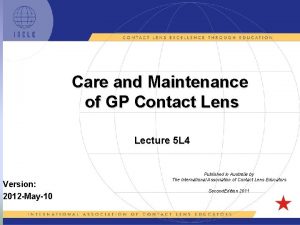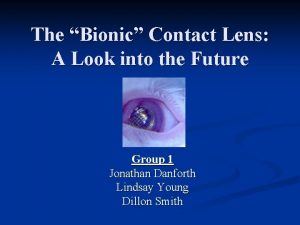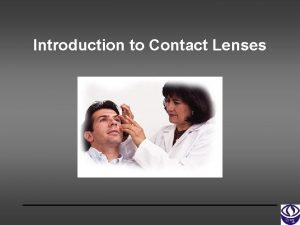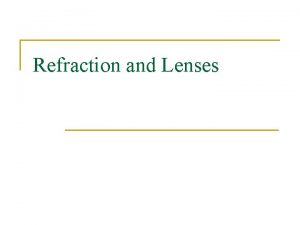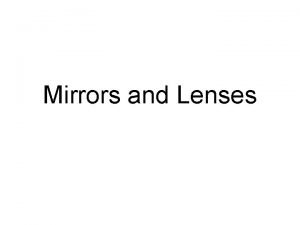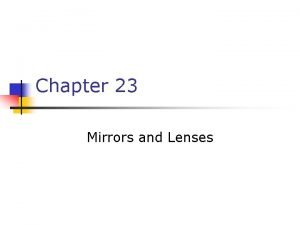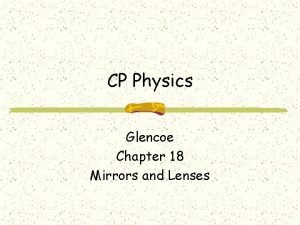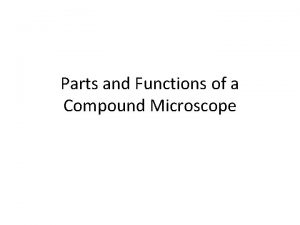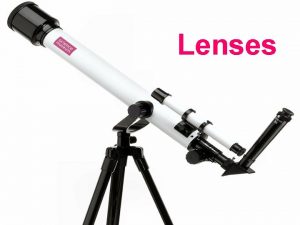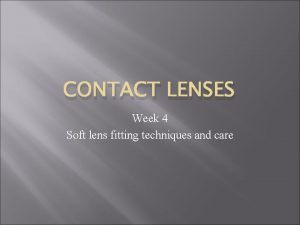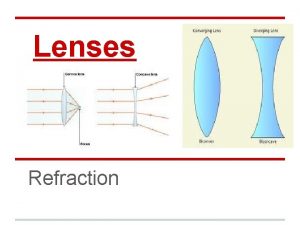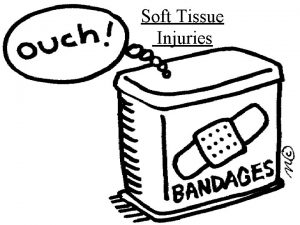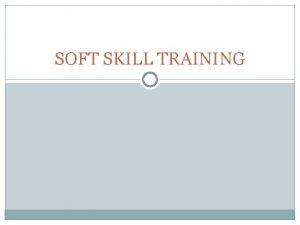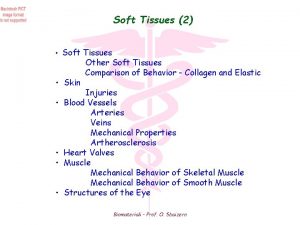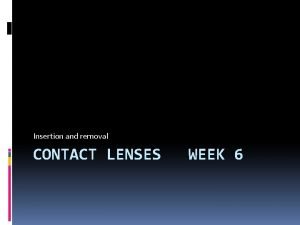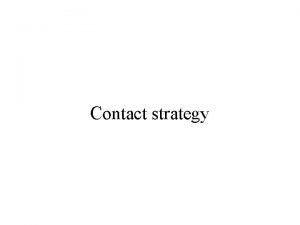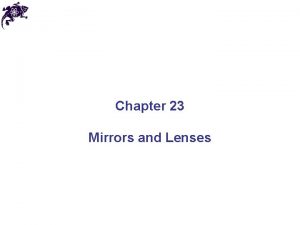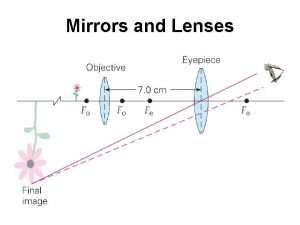Contact Lenses Week 5 Toric lenses and soft






















- Slides: 22

Contact Lenses Week 5 Toric lenses and soft CL problems

Toric Lenses used to correct astigmatic/sphericocylin drical patients. Toric lenses have a ballast or “weight” on the bottom of the lens to help keep the axis where it should be. The lens may rotate after blinking but will return to the desired axis because of the ballast. Each toric lens has markings on the lens itself to help the examiner determine if the lens is fitting properly. Most toric lenses have markings or “scribe marks” inferiorly at 6: 00 and 2 more scribe marks at 5 and 7. The people who will be most successful in torics will have a cylindrical axis close to 90 and 180 degrees.

Toric lenses Types of ballast in toric lenses Types of scribe marks on toric lenses.

Toric lenses People who will not do well in toric lenses: Patients with tight lids. Narrow palpebral fissure. Poor tear quality or quantity. Refractive astigmastism grater than +2. 75 D. Toric lenses are available from +4. 00 to -8. 00 in spherical power and 0. 75 to-2. 50 in cylindrical power. Base curves =8. 3 to 8. 9 Diameters=13. 8 to 14. 5

Toric lens fitting Base curve and diameter is fit the same as spherical CL. Refract patient to get power needed. Transpose power to minus cylinder. Put trial lens in that power on eye. Allow the lens 2030 minutes to settle. Take VA, if VA is NOT what expected, over refract spherical/cylinder power only. Put axis to trial lens axis. Evaluate BC, D and scribe marks with slit lamp exam. If the slit lamp exam reveals the scribe marks are in good position, and BC and D are fine you are done! If BC and D are not correct, note in chart and make modifications. If hash marks are not in correct position, use the Lars principle.

Toric lens fitting Transposition Refraction= -5. 50+150 X 90 Transpose to –cyl= -4. 00 -150 X 180 Refreaction= +3. 25+0. 75 X 90 Transpose to – cyl= +4. 00 -0. 75 X 180 Remember……. If the spherical power is+/- 4. 00 D, You will need to convert the power to compensate for vertex distance to get the effective power.

Toric lens fitting Over-refraction If VA is not what was anticipated, you need to modify the spherical/cylindrical power of the trial lens to improve VA. AXIS MUST BE SAME AS TRIAL LENS. With the trial lens on the eye, refract the patient with spherical/cylindrical power only, to see if the VA will improve with more or less spherical/cylindrical power. If you get improvement, modify trial lens power. Trial lens power= -4. 00 -1. 25 X 90 Over refraction= +0. 50+0. 25 X 90 Add over refraction to existing power after transposing +0. 75 -0. 25 X 180 -3. 25 -1. 50 X 90 new trial lens Trial lens power= +8. 75 -2. 25 X 180 Over refraction= -0. 75+0. 50 X 180 Add over refraction to existing power after transposing. -0. 25 -0. 50 X 90 +8. 50 -2. 75 X 180 new trial lens Do not try to refine the axis. The axis stays the same as the trial lens!!!

Toric lens fitting LARS Principle Lars rule(principle) or clockwise/counterclockwi se rule can be used to compensate for the misalignment of the lens axis so it will match the patient’s refractive axis. Sometimes, even though there is a ballast, the CL doesn’t stay where it is supposed to and then the axis will be “off” causing blurry VA. Lars is an acronym for Left, add, right, subtract. When looking through the slit lamp, if the hash marks are rotating to the fitter’s left, the number of degrees off rotation should be added to the trial lens axis. If the hash marks are rotated to the fitter’s right, the number of degrees off should be subtracted from the trial lens axis.

Toric lens fitting LARS Picture the CL as a clock, there are 60 minutes on the clock (360 degrees). Every “minute” equals 6 degrees. Every “minute” the hash marks are “off” equals 6 degrees of misalignment. A hash mark that orients at 7 o’clock instead of 6 o’clock is 5 “minutes” off. 6 degrees X 5 minutes= 30 degrees. The axis is 30 degrees off of where it should be, causing a blurring effect and decreased VA.

Toric lens fitting Trial lens= -4. 00 -2. 25 X 90 Figure 3. 7= 3 minutes off=18 degrees. The hash marks are to the fitter’s left, so we ADD 18 degrees to the trial lens axis. New trial lens axis= -4. 00 -2. 00 X 108. Figure 3. 8, also 18 degrees off but we SUBTRACT from the axis because it is to OUR right. New trial lens axis= -4. 00 -2. 25 X 72

Toric lens fitting Bounce back test CL will center and hash marks will be on 5, 6, &7 before blink. After blink, the hash marks will rotate. 2 -3 seconds after blink, the hash marks should return to 5, 6 & 7 and be centered on eye. If there is NO movement, the lens is too tight. You want the lens to rotate and move, just make sure it rotates and moves back where it belongs!

Toric lens fitting Review Perform ocular exam. Determine power, BC, and D. Put trial lens on eye for VA and fit evaluation. Test VA, do over refraction if needed. Transpose and recalculate new trial lens power. Do slit lamp exam for trial lens fit ( to flat or steep) and look where hash marks are aligned. If misaligned, apply LARS method and note new axis. Take all changes noted and apply to a new trial lens. Reapply new trial lens to eye and start all over! Hopefully all of the modifications are correct and the fit and VA is perfect.

Toric lens problems and complications Problems and complications can happen because of hypersensitivity, not enough oxygen delivery, bacterial, viral or fungal colonization, inflammatory response or improper fitting. We need to fit the lenses properly and educate the patient so these problems can be avoided or recognized and fixed.

Toric lens complications Micro mechanical trauma, corneal abrasion Staining on corneal surface due to dry eye or insuffient cleaning

Toric lens complications and problems Corneal edema due to hypoxia CL comlications

Toric lens complications and problems Mechanical, torn soft CL Fungal cells on corneal

Toric lens problems and complications conjunctivitis Subepithelial infiltrates due to chronic hypoxia, white blood cells collect in epithelial pockets.

Toric lens problems and complications Ulcerative bacterial keratitis pseudomonas

Toric lens problems and complications pseudomonas acanthomoeba

Toric lens problems and complications Giant papillary conjunctivits More GPC

Toric lens problems and complications � Your instruction and fitting are very important for the health of the patient’s eye. � Make sure the lens is fit properly. Always evaluate your fit under the slit lamp to ensure a good fitting lens. � Make sure the patient know the correct way to handle and clean the lenses. � You are the person responsible for teaching the patient care and handling. Never let a patient leave without understanding the rules!

THE END! � See you next week for insertion and removal. � Have a great week.
 Symfony iol calculator
Symfony iol calculator Hanita toric calculator
Hanita toric calculator Toric artiflex
Toric artiflex Which force
Which force Which of the following is sliding contact bearing
Which of the following is sliding contact bearing Service marketing chapter 2
Service marketing chapter 2 What are some contact forces and some noncontact forces
What are some contact forces and some noncontact forces Air resistance contact force
Air resistance contact force Contact lens drawing
Contact lens drawing Wettability of contact lenses
Wettability of contact lenses Bionic lens
Bionic lens Contact lens
Contact lens Is air resistance a non contact force
Is air resistance a non contact force Non contact forces portfolio
Non contact forces portfolio Dermatitis atopica icd 10
Dermatitis atopica icd 10 Non contact force definition
Non contact force definition Shottky contact
Shottky contact Week by week plans for documenting children's development
Week by week plans for documenting children's development Refraction by a lens
Refraction by a lens Mirrors and lenses
Mirrors and lenses Sign convention for lenses in tabular form
Sign convention for lenses in tabular form Physics classroom lenses and mirrors
Physics classroom lenses and mirrors Function of the compound microscope
Function of the compound microscope
